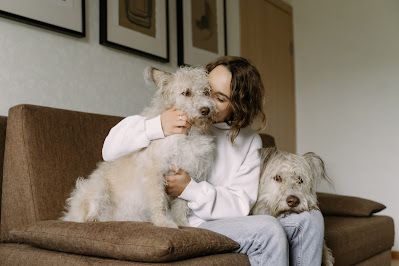More Than 40 Percent of Dog Owners Believe Their Dog Is In Better Shape

Dog Owners Believe Their Dog Is In Better Shape by an average of 40 percent. This intriguing statistic raises questions about the reasons behind this perception and the factors that contribute to it. Why do dog owners hold this belief, and what does it say about the bond between humans and their canine companions? As we explore the complexities of this phenomenon, we will delve into the influence of regular exercise routines and specialized diets for dogs, as well as the dedication of dog owners to ensuring their pets’ optimal health. So, let’s uncover the fascinating world of dog ownership and the unique perspective that many owners have about their dogs’ fitness levels.
The Perception of Dog Owners
The perception of dog owners regarding their dogs’ well-being and physical condition is a topic of interest, with a significant number of owners believing that their dogs are in better shape than they are themselves. This perception is not unfounded, as dog ownership has been associated with increased physical activity and improved health for the owners. Studies have shown that dog owners, particularly those who regularly walk their dogs, engage in more physical activity compared to non-owners. This increased physical activity is attributed to the daily walks and exercise routines that dog owners undertake with their pets.
For new dog owners, the sense of obligation to provide for their dogs’ physical needs often leads to an increase in their own physical activity. Walking their dogs becomes a regular part of their daily routine, which in turn improves their own health and fitness levels. In fact, research has shown that dog owners who walk their dogs are more likely to meet the recommended guidelines for physical activity.
Furthermore, dog walking has been associated with social support and enhanced quality of life. Interactions with other dog walkers during walks can provide a sense of community and companionship, leading to improved mental well-being. Additionally, the responsibility of pet ownership can give dog owners a sense of purpose and fulfillment, which can positively impact their overall sense of well-being.
Factors Influencing Belief in Dog’s Fitness
Belief in a dog’s fitness is influenced by various factors, including the size, breed, exercise requirements, and health/ability of the dog, as well as the perceived social support and neighborhood walkability. Research has shown mixed evidence regarding the association between dog-related factors and dog-walking behavior. For example, some studies have found a positive association between the perceived exercise requirements of dogs and dog walking. Dog owners tend to believe that dogs requiring considerable exercise are walked more frequently. However, the association between other dog-related factors, such as the number of dogs, size, type/breed, neuter status, and weight status, and dog walking behavior is less clear.
Furthermore, studies have shown mixed evidence regarding the association between social support and dog walking. Some studies have found a positive association, suggesting that dog owners who perceive higher levels of social support are more likely to engage in dog walking. However, other studies have found no significant association between social support and dog walking.
Similarly, the association between neighborhood walkability and dog walking is also mixed. While some studies have found a positive association, indicating that dog owners living in more walkable neighborhoods are more likely to engage in dog walking, other studies have found no significant association.
It is important to note that regular physical activity has numerous health benefits, and dog owners are generally more physically active than non-dog owners. However, the direction of the relationship between dog ownership and physical activity is unclear. Some studies suggest that dog owners are more physically active because they engage in regular dog walking, while other studies indicate that more physically active individuals are more likely to acquire a dog.
Dog Owners’ Dedication to Pet Health
Dog owners demonstrate a strong dedication to their pet’s health, as evidenced by their commitment to their dog’s physical, emotional, and mental well-being. Numerous studies have shown that dog ownership promotes regular physical activity, benefiting both the owner and the dog. Dog walking, in particular, has been found to have a positive association with human health.
Research has consistently shown that dog owners are more likely to engage in regular physical activity compared to non-dog owners. A study conducted by the American Heart Association found that dog owners were more likely to meet the recommended levels of physical activity compared to non-dog owners. Another study published in the Journal of Physical Activity and Health revealed that dog owners were more likely to engage in regular moderate to vigorous physical activity.
The benefits of dog ownership and walking extend beyond physical health. Owning a dog has been shown to have a positive impact on emotional well-being. The companionship and unconditional love provided by dogs can reduce stress and improve mood. In fact, studies have found that dog owners experience lower levels of depression and loneliness compared to non-dog owners.
Furthermore, owning a dog can have a positive impact on mental health. Dogs provide a sense of purpose and responsibility, which can improve self-esteem and overall mental well-being. Research has also shown that dog owners are more likely to engage in activities that stimulate cognitive function, such as playing with their dogs and training them.
Exercise Routines for Dogs
Regular exercise is essential for maintaining the overall health and well-being of dogs. Dog owners play a crucial role in ensuring that their pets receive adequate physical activity. One of the most common forms of exercise for dogs is dog walking. Studies have shown that dog owners are more likely to engage in regular walks and are generally more physically active than non-dog owners. Dog walking adds significantly to the amount of exercise done by dog owners, leading to increased physical activity and potential weight loss.
Several factors correlate with dog walking habits. The size and age of the dog, as well as the owner’s age and education, can influence the frequency and duration of dog walks. For example, larger dogs may require more exercise compared to smaller breeds. Additionally, younger dogs may have higher energy levels and require more physical activity. The presence of a yard or time constraints can also impact the availability of walking opportunities for both the dog and the owner.
A study conducted by the American Heart Association found that dog owners who regularly walked their dogs had a lower risk of cardiovascular disease. This association suggests that walking a dog can have cardiovascular benefits for both the owner and the dog. However, it is important to note that the level of evidence supporting this association is limited, and future studies should explore the long-term effects of dog walking on cardiovascular health.
When acquiring a dog, owners must consider the exercise needs of the specific breed and age. Providing regular exercise routines tailored to the dog’s needs can help maintain their overall health and prevent potential weight issues. Additionally, standardized practical education on body condition score (BCS) assessment can assist owners in identifying and managing canine overweight, ensuring that their dogs maintain a healthy weight.
Specialized Diets for Canine Fitness
To further optimize your dog’s overall health and maintain their optimal weight, it is important to consider specialized diets tailored to their specific fitness and exercise needs. Specialized diets for canine fitness can play a crucial role in supporting your dog’s physical activity, weight loss, and overall well-being. These diets are designed to provide the necessary nutrients and energy levels required for your dog’s specific fitness regimen.
When it comes to specialized diets, high-protein, low-carb formulas are often recommended. These diets support muscle development and provide sustained energy during physical activity. Additionally, some specialized diets may contain added supplements like glucosamine and omega-3 fatty acids, which are beneficial for supporting joint health and mobility, especially for active dogs.
Determining the right specialized diet for your dog requires consultation with a veterinarian or a canine nutritionist. They will consider factors such as your dog’s breed, age, activity level, and overall health. These professionals have the expertise to recommend the most suitable diet that will help your dog achieve and maintain physical fitness.
It is important to note that specialized diets for canine fitness are not only beneficial for active dogs but also for dogs of all ages and activity levels. Whether you have just acquired a new dog or have had your furry companion for years, providing them with a specialized diet can help prevent obesity and promote a healthy weight. This is especially important as dog obesity is a growing concern, and a balanced diet is essential for maintaining physical fitness.
Dog Owners Believe Their Dog Is In Better Shape Frequently Asked Questions:
Are Dog Owners in Better Shape?
Dog owners tend to have more active lifestyles due to their exercise routines with their canine companions. This leads to improved fitness levels, weight management, and overall physical activity. Additionally, outdoor activities and bonding experiences contribute to their mental well-being.
What Percent of the Population Thinks Dogs Are Better Than Cats?
More than 40% of dog owners believe their dog is in better shape. This belief may stem from the benefits of owning a dog, such as their loyalty, impact on mental health, and ability to improve our physical well-being.
What Are the Statistics About Dogs and Their Owners?
Dog ownership has a multitude of benefits. Dogs can improve your health, reduce stress and anxiety, increase physical activity, and provide emotional support. They also make great companions for the elderly, aid in children’s development, and promote socialization and community engagement.
What Percent of People Are Happier With Dogs?
Dogs provide numerous benefits, including improving mental health, reducing stress and anxiety, promoting physical activity, and serving as companions for the elderly. Many people find happiness and joy through their bond with dogs.
What are some signs that my dog is in good shape?
Some signs that your dog is in good shape include a healthy weight, strong muscles,
clear eyes, and a shiny coat. Additionally, your dog should have good breath
and healthy gums, as well as an overall good energy level and a happy
disposition.
How often should I take my dog to the vet for a check-up?
It’s recommended to take your dog to the vet at least once a year for a
check-up. However, the frequency may vary depending on your dog’s age and any
health concerns they may have.
What are some common health issues that can affect dogs?
Some common health issues that can affect dogs include obesity, dental disease,
arthritis, allergies, and cancer. It’s essential to consult with your
veterinarian to prevent and treat any health issues your dog may be facing.
Is it necessary to provide my dog with mental
stimulation?
Yes, providing your dog with mental stimulation is important
for its overall well-being. Mental stimulation can help prevent boredom,
reduce anxiety, and promote mental health. Activities such as training, puzzle
toys, and spending time with your dog can all provide mental stimulation.
How can I ensure that my dog is getting enough exercise?
To ensure that your dog is getting enough exercise, you should provide them
with daily physical activity that is appropriate for their breed and age. This
can include activities such as walking, running, playing fetch, or swimming.
Additionally, you can consult with your veterinarian to determine the
appropriate amount of exercise for your dog based on their individual needs.
Conclusion
In conclusion, the survey reveals that over 40 percent of dog owners believe their dogs are in better shape than they are. This perception may be attributed to the higher physical activity levels of dog owners and their commitment to their pets’ well-being. Regular exercise routines and specialized diets play a vital role in maintaining canine fitness. The strong bond and dedication exhibited by dog owners towards their furry companions are evident in their prioritization of their dogs’ health and fitness.








